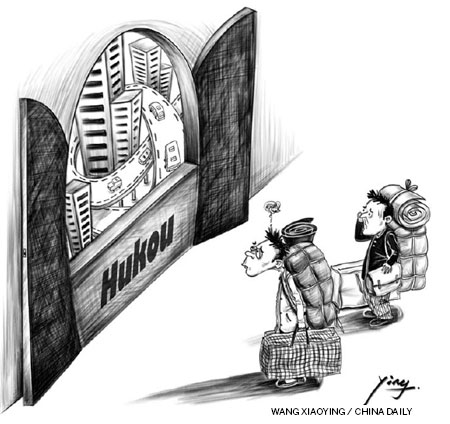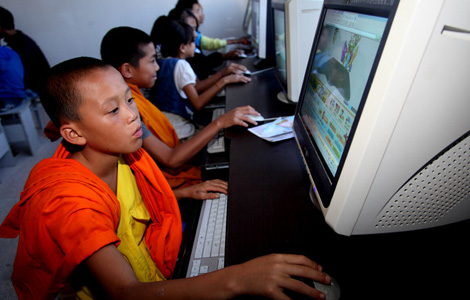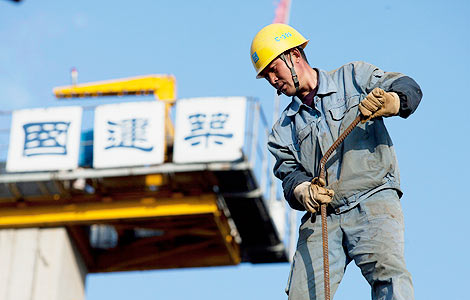People-oriented urbanization
Updated: 2013-02-26 08:06
By Fulong Wu (China Daily)
|
||||||||

The government recently announced that China's future development roadmap is a "new type of urbanization". Vice-Premier Li Keqiang uses the word urbanization to describe the transition toward towns and cities rather than the mega-urban growth of the past.
It symbolizes the departure from land-centered urban development to a form of people-oriented urbanization, which covers a broad scope. In the earlier phase of capital-driven urbanization, excessive conversion of rural land into urban areas, often through master-planned new towns, was the norm. Large-scale construction was accompanied by wholesale demolition. What is new in the roadmap for a new type of urbanization is its focus on the people.
The conversion of rural land into urban agglomerations is an incomplete and unfulfilled urbanization, while it excludes new migrants from being recognized as urban residents. While the relocation of people to metropolitan regions might be inevitable, urbanization does not mean a spatial concentration of the residents in the center of a city. The essence of urbanization is the provision of public services in contrast to a self-contained rural society. So far, farmers in the countryside have been largely left outside the sphere of service provision. This means that China has to reform its hukou system, which divides the urban and rural domains and further segregates the rural migrants from their host urban societies.
There might be some concerns that granting rural migrants an urban hukou overnight may exert pressure on public finances and that the existing urban residents might be reluctant to extend the services they enjoy to newcomers. To address these concerns, it might be useful to examine the function of hukou.
Under the planned economy, a hukou was linked with food supply from the State. Insulating farmers from the city allowed State-led capital-intensive industrialization. Economic reform and particularly the joining of the World Trade Organization led to a "world factory" model and hukou no longer prohibit physical mobility or restrict participation in the labor market. Other socioeconomic attributes being the same, migrant workers' hukou have no effect on their earnings. But what the hukou does do is confine rural migrants to the status of workers rather than citizens who can access public services. It also discourages migrants from becoming consumers.
Under investment-oriented urbanization, migrants were excluded from public services. This constrained domestic consumption and suffocated the opportunities for developing the service sector. The global economic crisis and trade imbalance require the shift from export-driven growth to a greater emphasis on domestic consumption as the engine for economic growth.
Rural migrants' access to urban housing indicates their awkward position. They are not entitled to government-funded affordable housing, nor can they afford to buy a house. Their hukou status, although it does not prohibit them buying a house, restrains their ability to do so and thus prevents them settling down in the city. They mostly stay in rental housing, forming "villages" in the city. However, their temporary accommodation is constantly subject to demolition.
Local governments are usually reluctant to grant migrants urban hukou, because under the current institutional arrangement local revenues are heavily dependent on the sale of land and migrants are seen as a burden rather than contributor to local economies. However, rural migrants come to the city for work. As part of the working population, even if they were granted urban hukou status they would not be welfare recipients. They are more likely to make a net contribution to a city. Therefore, a gradual change in the hukou system would be productive. The fiscal allocation may need to reflect the size of the population served by a local government.
People-oriented urbanization requires local governments to transform from an entrepreneurial actor in land dealings to a provider of public goods.
Some local officials may regard the roadmap of urbanization as a good opportunity to initiate large-scale construction and promote urban expansion, while others are concerned that boosting urbanization will inflate property bubbles further. However, the new type of urbanization emphasizes human rather than property development. The aim is for migrants to achieve higher wages and for existing urban residents to have a better quality of life.
The new form of urbanization means a greater tolerance to diversity of the built environment and more attention to the practical needs of residents and the functional convenience of everyday life. To plan our cities, we should avoid wholesale demolition and standardization in accordance with a blueprint of modernism. It is necessary to abandon image making, up-scaling and the construction of mega-urban projects under capital-intensive urbanization.
Quality of life should be one of the key guides for urbanization. This does not mean opulent and ostentatious consumption. Rather, it aims to meet the basic needs of human capital development: education, training, healthcare, recreation and care for the elderly.
Finally there needs to be greater attention paid to improving the environment, including some basic needs such as sanitation and the more advanced objectives of green development. Different from the "city beautiful movement", which emphasizes monumental and splendor architectural style and layout, "beautiful China" aims to develop a sustainable and ecologically friendly environment.
The author is Bartlett Professor of Planning at the University College London.
Related readings:
Urbanization challenges farmland conservation
Expert suggests caution over 'fragmented' urbanization
Urbanization set to boost growth
Reform land expropriation system for new urbanization











